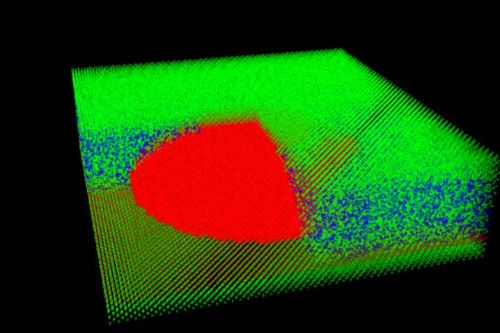Jul 11 2019
A research team from the University of Bristol has devised a new technique that could be applied to create quantum sensors with ultra-high precision.
 Atomistic structure of an artificial atom that could be used to produce light with vibrationally suppressed fluctuations for quantum-enhanced sensors. (Image credit: Gerhard Klimeck, Insoo Woo, Muhammad Usman, David S. Ebert (2011), “Self-Assembled Quantum Dot Wave Structure”)
Atomistic structure of an artificial atom that could be used to produce light with vibrationally suppressed fluctuations for quantum-enhanced sensors. (Image credit: Gerhard Klimeck, Insoo Woo, Muhammad Usman, David S. Ebert (2011), “Self-Assembled Quantum Dot Wave Structure”)
Individual atoms emit light in discrete packets known as photons. Upon measuring this light, the discrete or “granular” nature results in specifically low fluctuations in its brightness, since two or more photons are never emitted simultaneously.
This feature is specifically beneficial to develop future quantum technologies, in which low fluctuations are important. It has also resulted in increased attention in engineered systems that function similar to atoms when they emit light, but with properties that can be more easily customized.
They are called “artificial atoms” and essentially composed of solid materials. They are considerably larger objects, in which the existence of vibrations is inevitable and is often regarded to be destructive.
However, a collaborative group of researchers, headed by the University of Bristol, has currently shown that these vibrations that naturally occur in artificial atoms can fascinatingly result in even greater inhibition of fluctuations in brightness compared to what exists in natural atomic systems.
The researchers, including academics from the universities of Manchester and Sheffield, demonstrate that it could be possible to use these low fluctuations to create quantum sensors that are intrinsically more accurate compared to those possible without vibrations.
The study outcomes have been reported in the Nature Communications journal on July 10th, 2019.
The implications of this research are quite far reaching. Usually one always thinks of the vibrations present in these relatively large artificial atoms as being detrimental to the light they emit, as typically the vibrations jostle the energy levels, with the resulting fluctuations imprinted onto the emitted photons.
Dr Dara McCutcheon, Study Principal Investigator and Lecturer in Quantum Engineering, School of Physics, University of Bristol
McCutcheon added, “What’s happening here though, is that at low temperatures the vibrational environment acts to cool the system—in a sense freezing the energy levels, and in turn suppressing fluctuations on the emitted photons.”
This study highlights a new concept for these artificial atoms, where their solid-state nature is made better use of in reality to generate light that could not be produced using natural atomic systems.
The study also paves the way for a new set of applications in which artificial atoms are used for quantum enhanced sensing, right from small-scale magnetometry that could be applied to measure signals in the brain, up to full-scale gravitational wave detection that unravels cosmic processes occurring at the center of galaxies.